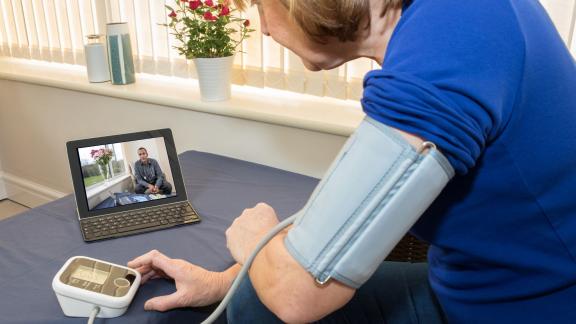Virtual wards need increased investment and staffing to deliver for patients

Rezina Hakim describes the ambitions behind virtual wards and what else is needed to support scaling up and quality of patient experience.
This article was first published in July/August's Public Sector Focus.
The use of virtual wards in the NHS is continuing to grow rapidly as a real alternative to in-patient, hospital care in the traditional sense of care giving within the bricks and mortar hospital care we as a nation have become so very familiar with.
While the use of virtual care, which often takes many forms of delivering and receiving virtual services, has been widespread in the NHS for some time, it is only during the COVID-19 pandemic that necessity began to dictate its growth. The impact of COVID-19 and ongoing capacity constraints in many parts of the system, means the NHS as a whole still feels extremely pressured especially at crucial periods including in winter. Crucially, in acute care this can mean patients waiting to be seen for longer than they should. To address and support some of these demands, capacity and flow challenges using more virtual care is a no-brainer.
Digital appreciation
Digital alternatives to face-to-face care can have enormous benefits for both the population and for the NHS in managing its resources and alleviating pressures on the systems. Our own survey findings shows that the majority of patients are willing to use digital technology to avoid going into hospital. NHS England’s Winter Plan 2023/24 published in July reiterated the favour of virtual wards, already committed to in the urgent and emergency care plan and more importantly, the overall target of delivering 40-50 virtual wards per 100,000 people by the end of 2023.
Chief among the many benefits of virtual wards is people being cared for in their own homes, something which has been shown to speed up recovery
To successfully expand virtual wards, understanding the drivers for a specific care pathway is crucial and this is often led in strong co-design with both patients and clinicians.
Our members – NHS leaders – frequently tell us of the benefits they see virtual wards bringing to care pathways. When done well the model is seen as a successful way to keep people out of hospital, to discharge people home as soon as they are medically fit to leave hospital, to reduce clinical time and give patients autonomy and choice in their own surroundings.
To successfully expand virtual wards, understanding the drivers for a specific care pathway is crucial and this is often led in strong co-design with both patients and clinicians.
Making sure senior consultants are engaged early on and championing peer-to-peer virtual ward design also creates a strong level of motivation and support systems which enable successful virtual wards to be replicated in other systems. The idea of ‘virtual ward champions’ whose role it is to spread awareness across the hospital by working across multidisciplinary teams; joining up conversations and relationships between specialties and staff; informing patients across departments and sharing good practice, can also help create a permissive and innovative environment where virtual wards can flourish.
Obstacles to overcome
However, there are a number of limiting factors to the success of virtual wards.
High staff vacancy rates across the NHS will invariably affect the ability to expand virtual wards nationally. The use of digitally enabled care is not spared from the impact of a depleted workforce and having the right mix of on-site staff as well as staff to service remote care via virtual wards is an ever-present challenge to meeting the expansion targets for virtual wards.
In the longer-term NHS leaders have stressed that simply measuring the activity of virtual ward bed numbers against the national target will not give us the true measure of their success. Designing the care pathway both for the present and for the future so as to fully incorporate them needs to be based on a clear understanding of demand. Transparent and available data which helps shape priorities for improving patient outcomes including evidencing prevention in the population, freeing up bed capacity and financial efficiencies are vital for future care modelling and judging the true efficacy of virtual wards.
The long-term success of virtual wards will also come down to having secure investment over many years
Too often the virtual ward target set nationally becomes the main driver for establishing the service without giving local leaders the autonomy to design the methodology and lead the design of the care pathway – which is specific to their population needs – and where the biggest impact for patients can be made. Longer-term virtual wards should utilise community care led design models and be more flexible in design where they move beyond acute centric care.
Ultimately, the long-term success of virtual wards will also come down to having secure investment over many years so that benefits – over a range of specialities – can be monitored and evaluated for improved health outcomes for local populations overall.
Rezina Hakim is senior policy adviser at the NHS Confederation. You can follow Rezina on Twitter: @hakimrezina



